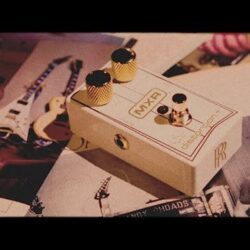
Dunlop Releases Special Edition of Randy Rhoads MXR® Distortion+
Last year, we released the MXR Randy Rhoads Distortion+, a pedal that celebrates Randy Rhoads’ revolutionary contribution to rock ’n’ roll guitar playing. The original MXR Distortion+ was a key part of his riveting sound, and our MXR engineers worked directly with sister Kathy Rhoads to ensure that this tribute would be equipped with all the components necessary to accurately recreate that sonic signature. The first run sold out quickly, leaving fans clamoring for another chance at those iconic tones. And now, it’s back.The Randy Rhoads MXR Special Edition Distortion+ features a clean white finish with pinstripe accents, inspired by the iconic Flying V-style guitar that Randy designed after flying on a famous supersonic airliner while touring with Ozzy Osbourne.Randy Rhoads MXR Special Edition Distortion+ highlights:A tribute to the monumental legacy of Randy RhoadsRecreates the raw, overdriven tones heard on his most beloved hitsPainstakingly spec’d from Randy’s own MXR Distortion+Designed with the direct involvement of sister Kathy RhoadsCustom finish inspired by his supersonic V-inspired guitarIncludes exclusive collector’s bookletAvailabilityThe Randy Rhoads MXR Special Edition Distortion+ is available now at $189.99 street/$271.41 MSRP from your favorite retailer.
Read more »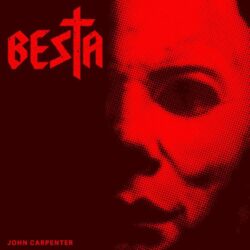
Track Premiere: Besta – “Estrela Negra”
The beast is back. Portuguese grindcore crushers Besta re-visit their 2014 homage to John Carpenter, with a fresh mix and new vocals on “Estrela Negra.”
The post Track Premiere: Besta – “Estrela Negra” appeared first on Decibel Magazine.
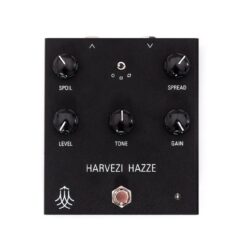
SOMA Harvezi Hazze Review
Any distortion pedal with white text on a matte-black finish is going to draw comparisons to Pro Co’s beloved rodent, the RAT, but SOMA Laboratory’s Harvezi Hazze offers a much more versatile brand of distortion. It’s a smartly designed, do-it-all transistor distortion and waveshaper—a function that changes waveforms from, for instance, sine, to square, to triangle, altering the output significantly. Together, the Harvezi Hazze’s circuit and interactive controls summon many unusual tones that go beyond simple distortion. Spoil Sport Harvezi Hazze’s three lower knobs—level, tone, and gain—need little description. Up top, though, there’s a switch for selecting from soft-clipping, hard-clipping, or “total feedback mode,” as well as knobs labeled spoil and spread. Spoil sets the amplitude threshold at which the waveshape change takes place, and spread sets the intensity. These two knobs, and the interplay between them, are the beating heart of Harvezi Hazze, and the key to unlocking the most unusual dirt.A suite of six switches on the side of the enclosure greatly expands the Harvezi Hazze’s palette. From first to last, they activate the tone circuit, boost bass frequencies, change how the tone knob functions, change the central frequency of the tone sweep, cut highs, and engage a preset compressor situated just after the input. Jams from GeorgiaThe Harvezi Hazze’s wavehaper is based around unijunction transistors sourced from e-waste bins at flea markets in Tbilisi, the capital of the nation of Georgia. (The pedal’s Georgian name roughly translates to “a fault on the transmission line” or “signal jamming.”) The obscure transistors help the Harvezi Hazze cover tones from gentle distortion mixed with clean signal to warped, sputtering mayhem. In my testing, I discovered so many fascinating, musically pleasing sounds that I was stumped at how they all fit into one dirt pedal. The engineers at SOMA turned an impressive magic trick with this one.At times when I wanted heavier and dirtier sounds from the Harvezi Hazze I found that tweaking the spoil and spread settings, while altering with the tone knob, can squeeze much more aggressive and volatile sounds from the pedal. There is one drawback to all this versatility: Because the controls are all so interactive, small adjustments can leave you wondering where one sound went and how you arrived at the latest one, and the lack of presets means you’ll be taking lots of photos of your settings if you want to revisit them.The Verdict$336 for a distortion pedal is a big ask, but in terms of flexibility and range of possible sounds, Harvezi Hazze is up there with the most deeply featured distortion units on the market, and there are boutique offerings in this price bracket that deliver a tenth of what this pedal can accomplish. In the studio, you could track 10 different guitar parts with totally unique sonic fingerprints, all with the Harvezi Hazze. For the right players and producers, this pedal could be a one-stop tone shop, and a studio staple.
Read more »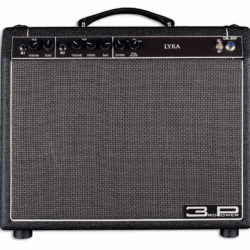
Introducing the LYRA: Two Legends. One Amplifier.
3RD POWER unveils the LYRA, a handcrafted tube amplifier that unites the voices of two of the most iconic amps ever made—the 1962 Deluxe and the 1965 Deluxe—in a single, elegantly designed package available in head format as well as 112 combo.Built for players who demand authentic tone and uncompromising versatility, the LYRA allows guitarists to step seamlessly between the warm, raw character of the early ‘60s and the refined clarity of the mid-’60s. With meticulous attention to detail, premium components, and vintage-inspired craftsmanship, this amp captures the soul of two eras while offering modern reliability and transportability. In use, each signal path is pure tube, focussed and effortless. Plug into either channel, or access them both with your favorite AB-Y pedal, and it feels alive – responsive to every touch, every note, as well as every silence. Tube driven spring reverb and our patented VenueMode attenuator are built in and round out the features.”The LYRA is about honoring history while inspiring new sounds,” says amp designer, Dylana Scott. “On stage or in the studio, it’s like having two timeless classics by your side,—ready at the flick of a switch.”The LYRA is now available in limited release.LYRA Features:Head or 112 Combo Versions Available’62 DELUXE Voice on Channel One’65 DELUXE Voice on Channel TwoTube driven Spring Reverb on boardDual 6V6 Power TubesPatented VenueMode™ Built-in Attenuator (20W/12W/5W modes)Custom Wound USA-made Power & Output Transformers by HeyboerHand-wired and Hand Built in Minneapolis, MNLimited Lifetime WarrantyPricing for LYRA is around $2799 (head version) and $3299 (112 combo). For more information, please visit www.3rdPower.com.
Read more »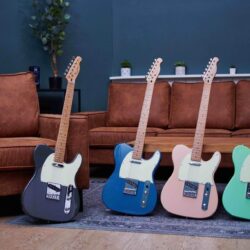
Tonewood Teardown: How Good Can a Cheap Guitar Sound?
Hello, and welcome back to Mod Garage. This month, we will start our custom-shop experiment with a very cheap electric guitar and see how far we can push it, customizing each and every little detail to see if the wood is really important regarding the amplified tone of an electric guitar.Basically, we will be putting high-quality parts into an extremely cheap guitar to see what will happen. The idea behind it is very simple: If the wood plays a major role in the amplified tone of an electric guitar, our cheap guinea pig can’t sound any good, no matter what we do. However, if it’s really all about the pickups, electronics, internal wires, guitar cable, strings, and, of course, the individual playing style, the cheap guitar has the potential to sound fantastic. (Another interesting experiment would be to put cheap pickups, electronics, wires, etcetera, into a high-end custom shop electric guitar, and see what happens!)“This is the perfect guinea pig for our experiment because it sports a lot of features that are considered ‘bad’ for the tone of a guitar.”You may remember the thesis from the last issue: The more solid an electric guitar is built, the less influence its primary structure has on the amplified tone. So to get this challenge started, I decided to use a Telecaster-style guitar, thanks to its very solid construction. I got a Harley Benton TE-62CC model from Thomann for $148 including shipping. It was delivered in a nice vintage seafoam green color. That’s a complete guitar for less than the price of a good pickup set, so what can we expect from it? It was important for me that the guitar wasn’t pre-selected, so I asked for a randomly picked instrument out of the pile, with the stipulation to not open the box and send it directly to someone else rather than to me so you can be sure I had no chance to do any work on this guitar. A big shout-out to Benedikt from Harley Benton to make all this happen.The guitar was shipped directly to my friend and colleague Haiko Heinz, who is not only a professional guitarist and teacher but also a renowned gear tester and columnist for the German online mag Bonedo. Haiko runs his own gear-review channel and has made countless gear-testing videos, so you can be sure that over the years he’s had his hands on virtually everything with 6 strings. I asked Haiko if he would make a “before video” of the guitar and he agreed; you can watch Haiko playing the guitar here. (After my work is done, I will ship the guitar back to Haiko and he will make another video to compare it with the stock factory condition.)After finishing the first video, Haiko sent the guitar to me, and I have to say that, considering the price, I was really impressed with the quality. It’s a standard vintage-flavored Telecaster, and the plan is to completely take it apart down to the last screw, analyse each and every little detail, and transform it into a much better guitar in terms of playability, comfortability, longevity, appearance, and, of course, tone. My goal is to keep the budget under $500, including the guitar, so I’ll be using a mix of new and used parts for our remaining $352. Let’s see how far we can get with this.The entire procedure is not set in stone. It’s just one possible way to do such a project, and certainly not the only way. I want to keep it as transparent and easy as possible so you can follow along, step-by-step, if you have a guitar you want to spruce up.So what can we expect from a guitar at this price? We can be sure that we’ll find some flaws and signs of cost-cutting under the high-gloss hood. This is the perfect guinea pig for our experiment because it sports a lot of features that are considered “bad” for the tone of a guitar. Here are the most prominent of them; we will talk about all of these in detail during this series.• The body is made out of basswood, which is not a classic tonewood.• The body is made out of multiple pieces of wood.• The body is not nitro lacquered but has an ultra-thick polyurethane finish, which we all know is killing tone because the wood of the guitar can’t breathe and resonate freely.• The “1-piece” maple neck is not one piece and has a glued-on maple fretboard, which is not vintage correct, and lessens high-end and attack.• The guitar is really lightweight so it’s not very loud and doesn’t sustain well.• It comes with thin strings which have less sustain and thinner tone.We can’t change the primary construction of the guitar (i.e. the wood used for its body and neck), so through the course of our mods we’ll see how much these things matter to a guitar’s tone. I’ll even install some lighter-gauge strings to really start from the lowest possible point tonewise—at least, according to Common Internet Guitar Knowledge (CIGK).After playing the guitar for a while and thinking about what to do with it, I decided to transform it into a single-pickup Esquire-style model, because less is often more. We will talk about the differences between a 2-pickup Telecaster and a single-pickup Esquire in detail and you will see it’s not the same tonewise.If you’re following along with one of your own guitars, your exercise for this month is to completely take it apart. I will do the same with my Harley Benton so we have the same starting point. Next month, we will start to work on the guitar, defining what to do and making some plans on how to proceed. The custom-shop game is open now, so stay tuned!Until then … keep on modding!
Read more »
BEST of Rig Rundown: Psych-Rock Pedalboards
Experience a sprawling collection of fuzz, delay, and modulation pedals that fuel massive walls of Pscyh-Rock sound. From vintage fuzz faces to boutique builds and custom creations, look back at classic Rig Rundowns from The Flaming Lips, All Them Witches, Elder, King Gizzard & The Lizard Wizard, and more.
Read more »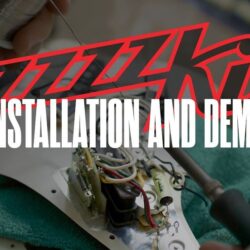
New BzzzzKill Device Solves Stratocaster 60Hz Hum Problem
The newly launched company BzzzzKill has introduced its debut product: a specially designed coil that drastically reduces hum in Stratocaster-style guitars.BzzzzKill solves a problem that has plagued Strat players for more than 70 years: single-coil pickup noise. The new BzzzzKill hum reduction device virtually eliminates Stratocaster 60 cycle hum without noticeable tone loss or permanent modifications to your guitar and its pickups.Unlike other solutions that require pickup replacements, permanent alterations, or external power sources, BzzzzKill employs a meticulously engineered passive dummy coil that installs inside your guitar’s control cavity without drilling.
On most Strat-style guitars, the installation process is straightforward and easily reversible, with no need for batteries, routing, or new pickups. Simply remove your pickguard, place the BzzzzKill coil next to the pickup selector switch, solder its wires to a few existing solder connections, and you’ll immediately hear a dramatic Improvement. Single-coil 60 Hz hum is virtually gone and your tone is retained.
BzzzzKill’s design finds the optimum balance between hum reduction and tone preservation. It’s currently available in two models. A Dual Layer model is specifically optimized for Stratocasters with reverse-wound/reverse-polarity (RWRP) middle coils. A Single Layer model is designed for vintage-style SSS (single-single-single) pickup configurations.
The innovative solution operates as a passive device requiring no batteries or maintenance, working in all pickup switch positions and remaining compatible with effects chains. The device maintains the guitar’s original dynamic range and low-end response while virtually eliminating hum at all gain levels except maximum gain settings, where only minimal hum remains.BzzzzKill is the culmination of decades of research and development by inventor Richard Moreton of RSM Custom Guitar Works. “I created over 200 prototypes in perfecting the BzzzzKill, mostly to solve my own quest for great tone and the ideal combination of hum reduction, and tone preservation,” says Moreton. “What started as a personal mission to get rid of the buzz in my own Strats became an obsession to create something that didn’t exist — one-and-done noise reduction without the compromises other solutions demand.”
Current BzzzzKill models sell for $199 USD for both the Single Layer and Dual Layer configurations. The company plans to expand to Telecaster and other single-coil models in the future. For more information visit www.bzzzzkill.com.
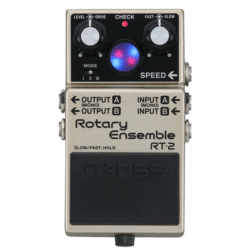
Boss RT-2 Rotary Ensemble Review
Ours is a frantically paced world. So, I quite like instruments and effects that slow my roll. Delays, reverb, and tremolo all do the trick nicely. But rotary-speaker-type effects can be every bit as good at slowing frantic, frenzied picking to a molasses pace.Whether a rotary-style pedal “spins” at a slow rate or a fast one … it’s all a lullaby to me. To truly distort time and have a decelerative influence, though, a rotary effect must create a real sense of depth. Boss’ RT-2 Rotary Ensemble possesses this kind of dimensionality in abundance. It’s syrupy and complex. And while it lacks some of the features that distinguish more embellished, contemporary rotary, vibrato, or Uni-Vibe-style pedals, the Boss’ smartly streamlined controls deliver subdued or in-your-face modulations in many shades, with functionality that doesn’t distract.Ode to RotationThough the RT-2 is, in many respects, a more compact riff on the Boss’ RT-20, which was discontinued in 2019, it isn’t as simple as it looks from five paces. The two knobs on the pedal’s face are actually four controls made up of two concentrically stacked dials. Two of the knobs set the speeds you move between when you press and hold the soft-latch pedal. The other two set the effect output level (which is handy for backgrounding or foregrounding the effect) and a drive circuit that approximates tube amp drive in a real rotary speaker. The drive control, though, can also be repurposed as a balance between virtual bass and treble “horns” when you slide a switch on the pedal’s crown. A second switch on the crown selects fast and slow ramp times between two rotary speeds.A third “mode” switch moves between three distinct effect voicings. The first, in Boss’s description, approximates the frequency response of a Leslie 122. To my ear it is the most open and neutral of the three. Mode II is described as having a wider tonal range more suited to drive and distortion. It’s much more focused in the midrange and slices like a machete when paired with a gain device or overdriven amp. Mode III is flat-out dirty, and while it sounds cool with distortion, it’s useful for achieving radical tone shifts in rigs with fewer effects. A lot of Hendrix and Gilmour fans will spend time here. The footswitch, in addition to functioning as the bypass, and the ramp switch can be reconfigured in different ways. Most notably, it can be used to activate the slowest rate of rotation first, or vice versa.Sundae SwirlThough some expensive, dedicated rotary speaker simulators may be better at achieving the mechanically derived, microtonal nuances of a real Leslie or Fender Vibratone, the RT-2 nails the mood and basic richness of the genuine article. The modulation pulses are distinctly hazy around the edges in a way a Uni-Vibe pedal or standard vibrato is not. At the slowest rates, these modulations can serve as a simple thickening agent in a fashion that almost mimics light boost or compression, particularly when the effect level is set to conservative zones. Faster modulations are more overtly rotary-like. Pitch shifts are less binary and bouncy and instead seem to melt into one another. And in a recorded mix with an appropriate sense of room ambience, you’d probably be hard-pressed to discern the RT-2 from a real Leslie.Though the drive control is effective for adding attitude and color to modulations, I derived a lot more utility and fun from using the control in its balance capacity. The ability to mix the virtual high and bass horns—effectively mimicking the microphone placement and mix emphasis when recording the treble and bass horns on a real Leslie—enables surgical placement of the effect in a mix. But it also helps summon the RT-2’s most natural and realistic rotary tones, and it’s the control I tinkered with most when exploring the pedal’s range.Accurately simulating a real rotary speaker remains one of the trickier feats in pedal design. Not coincidentally, the best simulators are pretty pricey. And while the RT-2’s $239 price tag can give pause, the pedal’s combination of no-fuss functionality, compact size, and often very delicious, convincing, and ecstatically elastic and animated approximations of a mechanical Leslie make crossing the $200 threshold a much more palatable proposition. And I’d venture that once you are fully immersed in the RT-2’s textures, and the surprisingly numerous, even unconventional, ways they can be applied, this well-executed pedal will pay back the investment many times over.
Read more »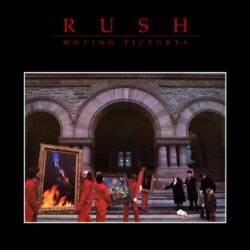
Alex Lifeson in the Limelight
Who could forget Alex Lifeson’s soul-stirring acceptance speech at the band’s 2013 induction to the Rock and Roll Hall of Fame: Yes, Rush are a “progressive rock band,” with all the weighty importance that it brings, but at their core is a sense of humor that allows them to not take themselves too seriously. The result is that, while their music may be complex at times, overall, it lacks the pretense and self-importance that can permeate bands of the genre.
Along with with late drummer Neil Peart’s masterful drumming and Geddy Lee’s vocals and powerfully melodic bass lines, it is Lifeson’s striking versatility that has made Rush one of rock’s most unique and compelling musical triangles for over 40 years:
Combining vast arrays of chiming chords …earworm-y riffs …thrilling solo flights …technical brilliance …and more, Lifeson’s inspiring creativity and musical savvy quickly become apparent to listeners. Let’s journey through some of the Canadian trio’s most classic songs to see if we can figure out just what makes him tick.Open Strings Are Our FriendsIn the debut episode of Premier Guitar’s Shred With Shifty, affable host and Foo Fighters guitarist Chris Shiflett, together with Lifeson himself, break down the latter’s solo from “Limelight,” off of 1981’s Moving Pictures. It kicks off with a clever use of a simple open B string, as shown in Ex. 1.Ex. 1As Lifeson explains, he doesn’t pick the harmonic. Instead, he lightly taps the ringing open string with a fret-hand finger at the indicated fret. (Lifeson uses his index; Shiflett, his middle.) Interestingly, the open B string wends its way through much of the song, including its trance-inducing chorus. Ex. 2 is inspired by this stirring section; note how the open B string acts as a hypnotic drone through all of the chords, a signature Lifeson move.Ex. 2You can take many open-position chord forms and experiment with moving them up the neck, while letting any open strings ring. Sure, you’ll inevitably hit some clunkers, but a good rule of thumb is, if the open string is in the key, you’ve got a good chance of finding some magic. Lifeson does just that in the intro to “La Villa Strangiato” from 1978’s epic, Hemispheres, as he positions a standard open G chord up at the 8th fret, creating a unique Cadd2 voicing.Ex. 3 is along the same lines; note how there are two open strings, D and G, that, when added to this very basic chord form, revitalize it to swirling effect.Ex. 3As in the “Limelight” solo, Lifeson cleverly weaves the open B string into his “YYZ” solo, Moving Pictures’ bombastic instrumental. Here, though, he employs it as a pedal point, a re-articulated or sustained note generally played below (or sometimes above) an accompanying melodic figure. Ex. 4 closes out his sinewy solo in grand fashion.Ex. 4Only the very first note is picked; the rest are sounded by a series of hammer-ons and pull-offs, which require some fret-hand strength to execute. A great exercise is to take the same figure and move it to other open strings, which is also a fun way to learn your scales horizontally across the neck. Throughout his solo, Lifeson employs B Phrygian dominant mode (B–C–D#–E–F#–G–A), which is simply the 5th mode of E harmonic minor (E–F#–G–A–B–C–D#). Fear not, all this means is that it’s the very same E harmonic minor scale, but here, B acts as the root or tonal center instead of E. Examples 5 and 6 apply this scale to the 1st and 3rd strings, respectively.Ex. 5Ex. 6Familiar Chords in Unfamiliar PlacesJust as how Lifeson uses open-position chord shapes up the neck with open strings, he also is adept at taking closed triad shapes (no open strings) and cleverly moving them in similar fashion. His solo in “Subdivisions,” from 1982’s Signals, rises to a climactic end this way, as shown in Ex. 7.Ex. 7This familiar “D” shape is one of three triad shapes found on each of the guitar’s sets of three strings. In other words, the same three notes (we’re excluding the open 4th string from the previous example) can be rearranged to find two other inversions along the neck. Let’s use them to play the same “Subdivisions” chord progression, but in different registers of the neck, as in Examples 8 and 9. Note in bar 2 of each how the new shapes lend themselves to different melodic choices and thus, new chord colors. Ex. 8Ex. 9Navigating Odd SpacesThe previous examples contain some interesting rhythms, something for which Rush is well-known, which includes the use of odd time signatures. Ex. 10 is reminiscent of a chordal interlude in “Jacob’s Ladder” from 1980’s Permanent Waves. Rush is a band that is exceptional at using odd time signatures in a most musical way, and here, they shrewdly shift from 5/4 to 6/4.Ex. 10To become more comfortable navigating these tricky time signatures, count either out loud or in your head while listening to the section. Doing so familiarizes you with how these time signatures feel, which eliminates the need for counting.Lifeson always sounds effortless when soloing in odd time signatures. A key way to accomplish this is to always be aware of where beat 1 is, so, for the moment, a bit more counting. But this time, do it while actually playing, as this will have you feeling at ease sooner than you might think. Lifeson’s solo in Moving Pictures’ “Red Barchetta” is in 7/4; note that an easy way to count your way through 7/4 is to break it down into 4/4 plus 3/4. Ex. 11 illustrates how he deftly negotiates one of the solo’s two-bar phrases in a memorably melodic way.Ex. 11The above is just a taste of the palette of colors from which Lifeson draws, as he weaves his guitars throughout Rush’s timeless catalog of songs. He, along with Lee and Peart, created unique and genuinely emotional music, none of which could ever be described as “blah.”
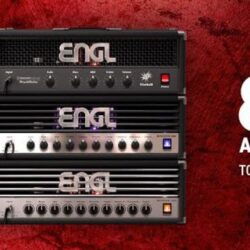
IK Multimedia Releases the ENGL Ampthology Volume 1Signature Collection for TONEX
IK Multimedia introduces ENGL Ampthology Vol 1, the first Signature Collection powered by the new TONEX Modeler. ENGL has earned a place among the most revered names in high-gain amplification, with a tone that has shaped the performance of metal, prog, and hard rock around the world.For the first time, that signature ENGL aggression and clarity have been captured directly from ENGL’s private vault of hand‑selected amps, meticulously curated for the official TONEX collection.”For decades, ENGL has defined the sound of high-gain excellence. With IK Multimedia’s TONEX technology, our iconic amps have been captured for you to unleash in the studio, on stage, or anywhere your music takes you.” – Edmund Engl, founder of ENGL AMPSENGL Collection Overview72 Tone Models based on six legendary amps from ENGL’s private collection, dialed in for this exclusive release.Created by ENGL tone masters using TONEX Modeler for enhanced high‑gain precision.Includes Amp, Amp + Cab, and Complex Rig Tone Models for ultimate flexibility in studio and live setups.Compatible across the entire TONEX ecosystem: Mac/PC, iOS, TONEX Pedal, and TONEX ONE.Compatible with all TONEX software versions, including the free TONEX CS.The Ultimate ENGL ExperienceENGL Ampthology Vol 1 offers instant access to six legendary ENGL amplifiers: the Fireball 60, Powerball MK1, Invader 100, Savage 120 MK1, Savage 60 MK1, and the pure tube tone of the ENGL Straight. Each amplifier offers a selection of exclusive Tone Models, including amp-only captures for maximum versatility.From crystal-clear cleans to crushing high-gain tones, with or without cab, these Tone Models capture authentic ENGL character in a mix-ready, studio-quality format that’s phase-perfect, ultra-responsive, and optimized for both studio and live use.Experience the full ENGL sound – without the volume, weight, or tube maintenance.Pricing and AvailabilityThe ENGL Ampthology Vol 1 is now available via ToneNET and within any version of TONEX for Mac/PC at a limited-time introductory price of $/€79.99* (reg. $/€99.99). *Pricing excluding taxes. For complete details and information about the ENGL Ampthology Vol 1 Signature Collection and to hear the tones, please visit: www.ikmultimedia.com/tonex-engl-vol1www.ikmultimedia.com/tonex-engl-vol1/video
Read more »